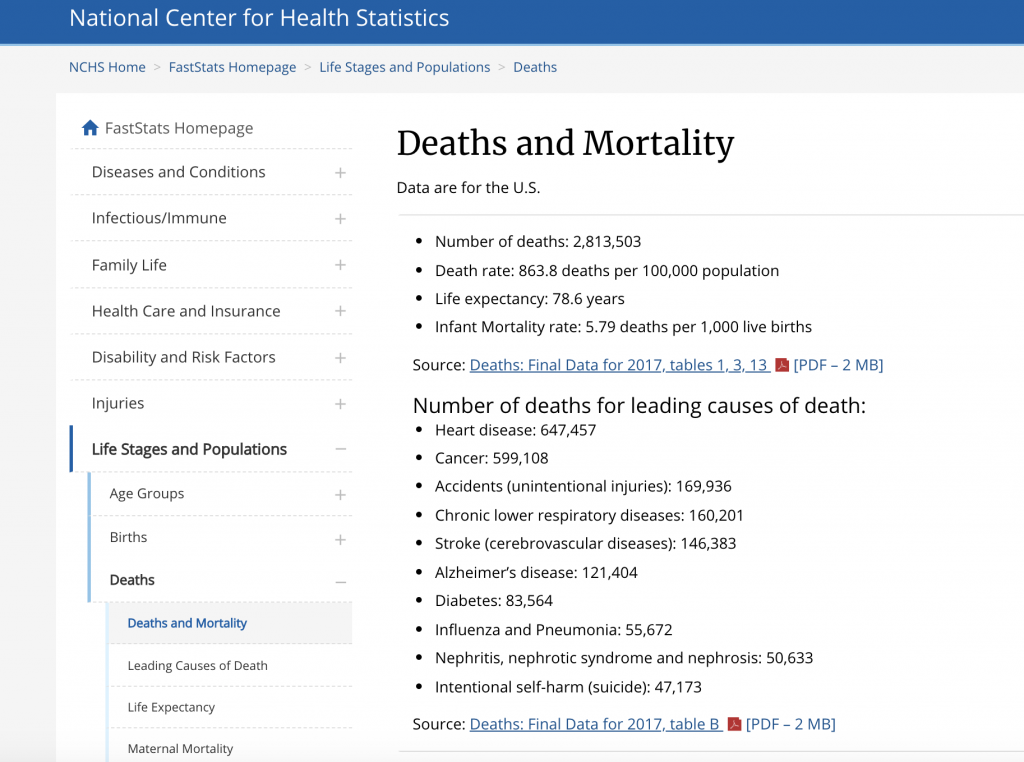Home » Coronavirus Mortality Reality Check
Coronavirus Mortality Reality Check

First, though, this: every death counts. I say that as a human, and humanist. I say it as someone with skin that bleeds when cut, just like yours, blood the same color. I say it as husband, father, brother, son. I say it as physician, and public health practitioner.
Every death counts. I say it as someone who has long railed against the passion-banishing routines of clinical medicine, and even more so the anonymizing veil of public health statistics.
Every death counts. And so my heart goes out to every family suffering loss from coronavirus. It goes out to every family experiencing loss from heart disease, cancer, stroke, and diabetes, too. It goes out all the more to every family enduring the devastating loss of a child to measles, influenza, cholera, malaria, or hunger. It goes out and aches for families losing young mothers, and their babies, in childbirth. It goes out to every family anguished by the plague of adolescent texting-while-driving fatalities.
Every death counts. But as the diverse causes above imply, rapt fixation on any one cause compounds the actual peril with the danger of massive distortion.
We are, it seems, to borrow from Elvis Costello, all but “waiting for the end of the world.” As we do so, and shutting down most of our customary diversions into the bargain, the coronavirus play-by-play becomes the national, indeed global, spectator sport of choice.
And your anxieties are no doubt calibrated accordingly.
Coronavirus, however, is not the only danger waiting out there, and for most of us, it appears to be far from the gravest. Here, for instance, are the most recent annual mortality statistics for the United States from the National Center for Health Statistics at the CDC.
Heart disease alone kills nearly 1800 people in the United States…every day. As I write this, that is very closely commensurate with the total number of coronavirus deaths to date in Italy. It is 25 times the total coronavirus deaths to date in the United States, and again- it happens every day. Every 3 to 4 days, just heart disease, just in the United States, kills more people than coronavirus has in the world in two months.
This is not to dismiss the danger of COVID-19 or deny the respect it warrants. But if the reason for that respect is the danger posed to life, limb, and loved ones- we are distorting it with regard to coronavirus, while overlooking many greater threats that hide in plain sight. This is an inevitable consequence of communal fixation at an all but unprecedented scale.
There is more. Coronavirus severity and mortality are, again based on the best available data we have thus far, massively concentrated among the already chronically ill, and especially among the elderly, as I’ve noted before. Where the denominator data are most reliable, roughly 99% of cases are reported as mild, posing no threat to life and not requiring hospitalization. The risk of death is highly concentrated among those over age 70 and especially 80, meaning the likelihood of exposure and recovery in the rest of us is considerably better than 99%, and more like 99.9%. Unlike the flu or measles, this infection has shown no tendency at all to cause death in children.
Every death counts. Any untimely death due to coronavirus is, and will be, a tragedy for those directly affected. But as someone with beloved family members in the “at risk” demographic, we all need another element of reality check, it seems to me.
Namely, people over 80 are prone to die with or without a pandemic. Life expectancy in the United States is 78.6. In an average year in the United States, nearly 1% of the population- about 3 million people- die. Many of those deaths are premature, but even so, most are in older people. That’s how life works for us mortals; we get old, and we die of something.
It does not diminish the significance of coronavirus to note that many of the deaths we attribute to it in real time as the world watches in restive anguish would go all but unnoticed by any save the families were they to occur at the same age from any less exotic cause. And, they do- every day.
That concentrated vulnerability has implications for containment and prevention in my view. We are practicing what we might call “horizontal interdiction,” as show below in Figure 1.
Figure 1: Horizontal interdiction. Containment resources are deployed to the entire population (the area shaded in gray), and social distancing is achieved with policy barriers displayed as bold lines between groups, but not by risk category within groups (e.g., families).
This method depends on interrupting transmission of the coronavirus in the entire population to prevent severe infection and death in the vulnerable “1%,” if we may borrow a designation from our roiling politics. In this case, that 1% is not defined by affluence, but by infirmity, and in particular, senescence.
I need not point out the societal cost of this approach; you are witnessing it with me in real time, as every normal function in our culture seemingly comes undone. The concern I append to it is that it spreads what limited public health resources we have far too thin, and is thus, in my view, unlikely to be effective for all of our pains.
What is the alternative? What I would call “vertical interdiction,” as shown in Figure 2.
Figure 2: Vertical interdiction. Containment resources are preferentially deployed to shelter and protect those known to be at elevated risk for severe infection and death (the area shaded in gray) until there is effective treatment, cure, vaccine, or undetectable community transmission. The portion of the population targeted for interdiction is above the bold line. Protection extends to barriers among generations within families, but allows much of “business as usual” to proceed at the level of our culture at large for those at “average” risk.
By way of analogy, and bearing in mind that all analogies are imperfect: horizontal interdiction of the variety now under way is a bit like taking all the lifeguards we have and deploying them fairly randomly into the general population to encourage swimming lessons, rather than placing them at pools and beaches to rescue those who can’t swim, or who get into trouble despite. Vertical interdiction is, conversely, stationing them at pools and beaches where the risk of adverse outcome is all but entirely concentrated.
If the math above is valid, why is the health system in Northern Italy so overwhelmed by the toll of coronavirus? Because the disease there is almost certainly spread to roughly ten times the number thus far documented, and that spread happened in a short period of time. Nothing immediate and effective was done to prevent transmission to the elderly, and Italy has an older population than any other country in Europe. With deep respect for our Italian colleagues, and condolences for the daunting battle they are waging, they were pitted against a perfect storm.
Do we face that same risk in the United States? Absent effective interdiction, we do. We also face the risk of overwhelming our medical system with unnecessary demand, as worry drives orders of magnitude more people to the very places they should avoid- clinics and hospitals- to seek testing that for the most part is not available anyway. My colleagues on the front lines tell me this is happening already.
Finally, how might we translate this into practical advice you can act on right now, since so much depends on public policy, and public health resources in short supply? (Note: we perennially under-fund public health and prevention, and are reaping what we have sown in that regard. Going forward, please lend your political capital to public health not in the midst of calamity when it is apt to be too late- but always, and proactively. Thank you!)
1) Identify those especially vulnerable (EV) to severe coronavirus infection among your family members, close friends, and co-workers/employees: the chronically ill, the immunocompromised, the elderly.
2) Help every member of the EV group practice robust social distancing from anyone who might acquire and transmit coronavirus, including other family members. For example, vulnerable grandparents should be staying away from, not gathering with, the college students now being sent home from campuses in large cities all around the country. They should be avoiding places like supermarkets where crowds congregate.
3) Seek advice, and devise strategies, to help EV group members you know and love address their needs for everything- food, other staples- in ways that minimize their potential contact with anyone who might have been exposed to the virus.
The above efforts would be much abetted by systematic, community-wide testing as is being done in South Korea. Sometimes the best, and sometimes the only, robust defense of our individual bodies resides with the body politic. Here’s hoping ours gets its act together sooner than later.
In the interim, though, do all you can to take matters into your own hands, and protect your older loved ones from exposure. Take comfort, too, in the mortality reality check. Death from coronavirus is highly, albeit not entirely, concentrated among the frail elderly. Let’s concentrate our protection efforts there, too; respect that every death counts, but stop counting every cause-specific death while making ourselves crazy; and stop waiting for the end of the world. Even such mayhem as that can be a self-fulfilling prophecy.
-fin
This article was first published on LinkedIn.




